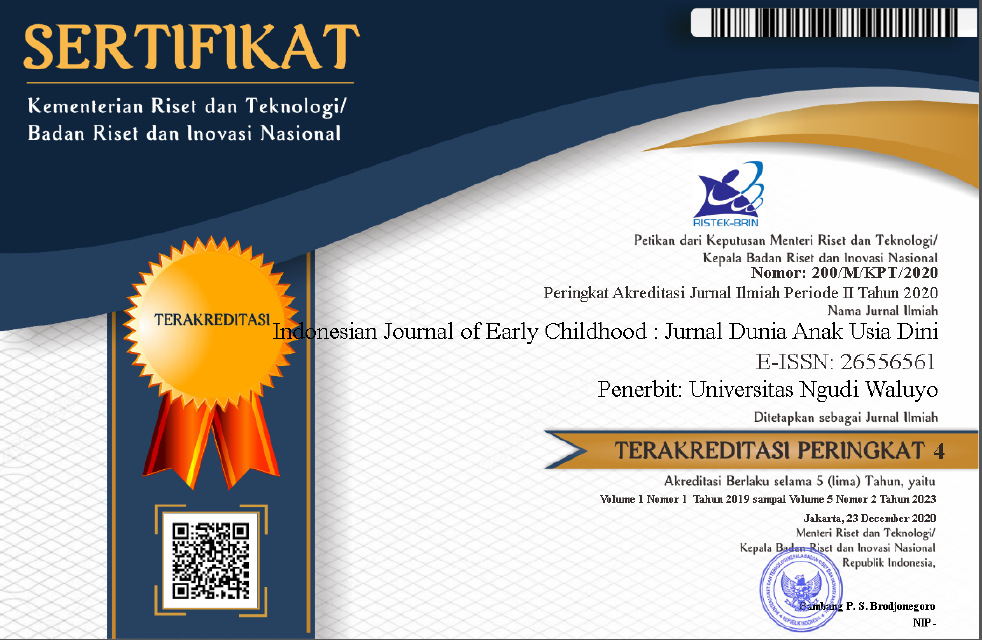Upaya Mengatasi Kedisiplinan Siswa di Lingkungan PAUD
Effective Strategies in Overcoming Student Discipline Problems in Early Childhood Education (PAUD) Environment
DOI:
https://doi.org/10.35473/ijec.v6i1.3082Keywords:
PAUD, Disiplin,, Manajemen Perilaku Siswa,, Strategi Efektif,, Profesional GuruAbstract
Facing general challenges in early childhood education (PAUD), especially related to student discipline problems, is the main focus that professional teachers must pay attention to. One crucial aspect is a deep understanding of student behavior management. Effective handling of this problem requires the right approach to ensure a smooth learning process. Discipline education in early childhood involves a clear understanding of the difference between behavior that is considered positive and negative. In this context, the approach to instilling discipline at an early age must be carried out in a friendly manner and through play interactions. The role of teachers, society and parents is very important in forming and teaching the values of discipline to children. This article aims to present several effective strategies for dealing with student discipline problems in PAUD. Teachers need to have skills in managing the classroom well to create a dynamic and effective learning environment, considering that there are students with diverse backgrounds. The teacher’s role is very crucial in solving student discipline problems because discipline is the key to success in all things. From this discipline, a consistent attitude will emerge in upholding principles, perseverance in business, strong in defending the truth, and never giving up. Therefore, this article will discuss various practical strategies that can help PAUD educators face and overcome challenges in maintaining student discipline.
ABSTRAK
Menghadapi tantangan umum di dalam pendidikan anak usia dini (PAUD) terutama berkaitan dengan masalah disiplin siswa, merupakan fokus utama yang harus diperhatikan oleh guru-guru yang profesional. Salah satu aspek krusial adalah pemahaman yang mendalam mengenai manajemen perilaku siswa. Penanganan yang efektif terhadap masalah ini memerlukan pendekatan yang tepat guna memastikan kelancaran proses pembelajaran. Pendidikan disiplin pada anak-anak usia dini melibatkan pemahaman yang jelas tentang perbedaan antara perilaku yang dianggap positif dan negatif. Dalam konteks ini, pendekatan untuk menanamkan disiplin pada usia dini harus dilakukan secara ramah dan melalui interaksi bermain. Peran guru, masyarakat, dan orangtua sangatlah penting dalam membentuk dan mengajarkan nilai-nilai disiplin kepada anak-anak. Artikel ini bertujuan untuk menyajikan beberapa strategi efektif dalam menangani masalah disiplin siswa di PAUD. Guru perlu memiliki keterampilan dalam mengelola kelas dengan baik untuk menciptakan lingkungan belajar yang dinamis dan efektif, mengingat adanya siswa dengan latar belakang yang beragam. Peran guru sangatlah krusial dalam menyelesaikan masalah disiplin siswa karena disiplin merupakan kunci kesuksesan dalam segala hal. Dari disiplin tersebut, akan timbul sikap konsisten dalam memegang prinsip, tekun dalam usaha, kuat dalam membela kebenaran, dan tidak mengenal kata menyerah. Oleh karena itu, artikel ini akan membahas berbagai strategi praktis yang dapat membantu pendidik PAUD menghadapi serta mengatasi tantangan dalam menjaga disiplin siswa.
References
Ansori, Y. Z., Nahdi, D. S., & Saepuloh, A. H. (2021). Menumbuhkan karakter hormat dan tanggung jawab pada siswa di sekolah dasar. Jurnal Educatio FKIP UNMA, 7(3), 599–605
Amelia, N. ., & Dafit, F. . (2023). Strategi Guru dalam Menanamkan Karakter Disiplin Siswa Sekolah Dasar. Jurnal Ilmiah Pendidikan Dan Pembelajaran, 7(1), 142–149.
Aulina, C. N. (2013). Penanaman Disiplin Pada Anak Usia Dini. Pedagogia : Jurnal Pendidikan, 2(1), 36-49.
Fahrudin, M. F., Nelyahardi, N., & Wahyuni, H. (2023). Strategi Guru Bimbingan dan Konseling dalam Meningkatkan Kedisiplinan Belajar Siswa Pasca Pandemi Covid-19 tingkat SMP Se-Kota Jambi. Innovative: Journal Of Social Science Research, 3(3), 9082-9097.
Hapsari, W., & Iftayani, I. (2016). Model pendidikan karakter pada anak usia dini melalui program islamic habituation. Indigenous: Jurnal Ilmiah Psikologi, 1(2)
Kurniawan, A. (2019). Manajemen Kelas Pendidikan Anak Usia Dini (Paud) Dalam Meningkatkan Kedisiplinan Belajar Siswa. AWLADY: Jurnal Pendidikan Anak, 5(2), 7894
Lahi, R., Syahniar, & Ibrahim, I. (2017). Faktor yang Mempengaruhi Pelanggaran Disiplin Siswa dan Implikasinya terhadap Layanan Bimbingan dan Konseling. Jurnal Pendidikan Indonesia, 3(1), 40–44
Lukitasari, S. (2017). Deskripsi Kedisiplinan Anak Usia 5-6 tahun di kb/tk pedagogia. Pendidikan Guru PAUD S-1, 6(3), 231-240.
Sari, D. Y. (2018). Pengaruh bimbingan guru dalam mengembangkan kemandirian dan kedisiplinan anak usia dini. Golden Age: Jurnal Pendidikan Anak Usia Dini, 2(2).
Waty, M. O. (2020). Strategi Penanaman Kedisiplinan Pada Anak Usia Dini Di TK Islam Darunnajah Ulujami Jakarta Selatan (Bachelor’s thesis, Jakarta: FITK IIN Syarif Hidayatullah Jakarta).
Disiplin Diri. (n.d.). (n.p.): Pinang.
Gentle Discipline. (2019). Indonesia: Bentang Pustaka.
Nelsen, J., S. (1997). Disiplin positif: rujukan hangat, praktis, mudah diikuti orangtua dan pendidik. Indonesia: Pustaka Delapratasa
PENDIDIKAN ANAK USIA DINI: Perspektif Dosen PAUD Perguruan Tinggi Muhammadiyah. (2020). (n.p.): EDU PUBLISHER.
Pendidikan Karakter Disiplin. (2021). (n.p.): Nusamedia
Downloads
Published
How to Cite
Issue
Section
License
Copyright (c) 2024 Indonesian Journal of Early Childhood: Jurnal Dunia Anak Usia Dini

This work is licensed under a Creative Commons Attribution-ShareAlike 4.0 International License.
Please find the rights and licenses in Indonesian Journal Of Early Childhood: Jurnal Dunia Anak Usia DIni. By submitting the article/manuscript of the article, the author(s) agree with this policy. No specific document sign-off is required.
1. License
The non-commercial use of the article will be governed by the Creative Commons Attribution license as currently displayed on Creative Commons Attribution-ShareAlike 4.0 International License.
2. Author(s)' Warranties
The author warrants that the article is original, written by stated author(s), has not been published before, contains no unlawful statements, does not infringe the rights of others, is subject to copyright that is vested exclusively in the author and free of any third party rights, and that any necessary written permissions to quote from other sources have been obtained by the author(s).
3. User Rights
Indonesian Journal Of Early Childhood: Jurnal Dunia Anak Usia Dini's spirit is to disseminate articles published are as free as possible. Under the Creative Commons license, Indonesian Journal Of Early Childhood: Jurnal Dunia Anak Usia Dini permits users to copy, distribute, display, and perform the work for non-commercial purposes only. Users will also need to attribute authors and Indonesian Journal Of Early Childhood: Jurnal Dunia Anak Usia Dini on distributing works in the journal and other media of publications.
4. Co-Authorship
If the article was jointly prepared by more than one author, any authors submitting the manuscript warrants that he/she has been authorized by all co-authors to be agreed on this copyright and license notice (agreement) on their behalf, and agrees to inform his/her co-authors of the terms of this policy. Indonesian Journal Of Early Childhood: Jurnal Dunia Anak Usia Dini will not be held liable for anything that may arise due to the author(s) internal dispute. Indonesian Journal Of Early Childhood: Jurnal Dunia Anak Usia Dini will only communicate with the corresponding author.
5. Miscellaneous
Indonesian Journal Of Early Childhood: Jurnal Dunia Anak Usia Dini will publish the article (or have it published) in the journal if the article’s editorial process is successfully completed. Indonesian Journal Of Early Childhood: Jurnal Dunia Anak Usia Dini's editors may modify the article to a style of punctuation, spelling, capitalization, referencing and usage that deems appropriate. The author acknowledges that the article may be published so that it will be publicly accessible and such access will be free of charge for the readers as mentioned in point 3.
Â
Every accepted manuscript should be accompanied by "Copyright Transfer Agreement" prior to the article publication.



